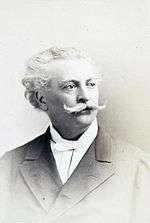Désiré Charnay
| Désiré Charnay | |
|---|---|
|
Désiré Charnay | |
| Born |
2 May 1828 Fleurieux-sur-l'Arbresle |
| Died | October 24, 1915 (aged 87) |
| Nationality | French |
| Fields | archaeology |
Claude-Joseph Désiré Charnay (2 May 1828 – 24 October 1915) was a French traveller and archaeologist notable both for his explorations of Mexico and Central America, and for the pioneering use of photography to document his discoveries.

He was born in Fleurieux-sur-l'Arbresle, and studied at the Lycée Charlemagne. In 1850, he became a teacher in New Orleans, Louisiana, and there became acquainted with John Lloyd Stephens's books of travel in Yucatan. He travelled in Mexico, under a commission from the French ministry of education, in 1857-1861; in Madagascar in 1863; in South America, particularly Chile and Argentina, in 1875; and in Java and Australia in 1878. In 1880-1883, he again visited the ruined cities of Mexico. Pierre Lorillard IV of New York City contributed to defray the expense of this expedition, and Charnay named a great ruined city near the Guatemalan boundary line "Ville Lorillard" in his honor; the name did not stick and the site is more commonly known as Yaxchilan. Charnay went to Yucatan in 1886.[1]
The more important of his publications are Le Mexique, souvenirs et impressions de voyage (1863), being his personal report on the expedition of 1857-1861, of which the official report is to be found in Viollet-le-Duc's Cités et ruines américaines: Mitla, Palenqué, Izamal, Chichén-Itzá, Uxmal (1863), vol. 19 of Recueil des voyages et des documents; Les Anciennes villes du Nouveau Monde (1885; English translation, The Ancient Cities of the New World, 1887, by Mmes. Gonino and Conant); a romance, Une Princesse indienne avant la conquête (1888); À travers les forêts vierges (1890); and Manuscrit Ramirez: Histoire de l'origine des Indiens qui habitent la Nouvelle Espagne selon leurs traditions (1903).[1]
He translated Hernán Cortés's letters into French, under the title Lettres de Fernand Cortès à Charles Quint sur la découverte et la conquête du Mexique (1896). He elaborated a theory of Toltec migrations and considered the prehistoric Mexican to be of Asiatic origin, because of supposed observed similarities to Japanese architecture, Chinese decoration, Malaysian language and Cambodian dress, and so forth.[1]
References
- 1 2 3
 One or more of the preceding sentences incorporates text from a publication now in the public domain: Chisholm, Hugh, ed. (1911). "Charnay, Claude Joseph Désiré". Encyclopædia Britannica. 5 (11th ed.). Cambridge University Press. p. 947.
One or more of the preceding sentences incorporates text from a publication now in the public domain: Chisholm, Hugh, ed. (1911). "Charnay, Claude Joseph Désiré". Encyclopædia Britannica. 5 (11th ed.). Cambridge University Press. p. 947.
External links
- Works by Désiré Charnay at Project Gutenberg
- Works by or about Désiré Charnay at Internet Archive
- Works available at Gallica, Bibliothèque nationale de France
- Photographs and prints of Uxmal and Kabah by Charnay (Reed College, Portland, Oregon)
- Ruines du Mexique et Types Mexicains From the Collections at the Library of Congress
- Les Anciennes Villes du Nouveau Monde From the Collections of the Library of Congress
